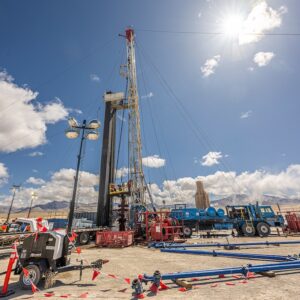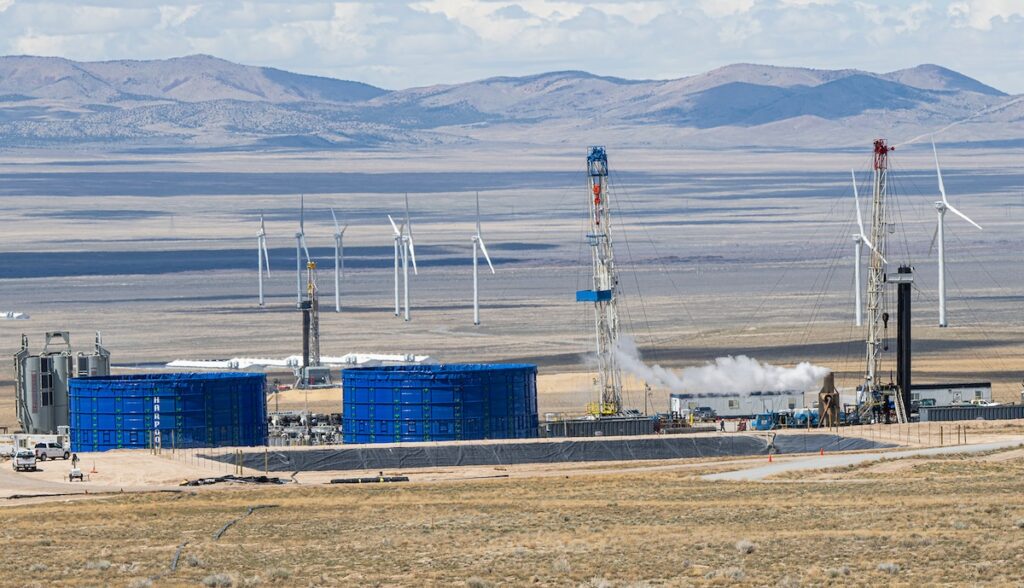
The Utah Frontier Observatory for Research in Geothermal Energy (FORGE) at the University of Utah has successfully stimulated wells 16A(78)-32 (injection) and 16B(78)-32 (production). A 9-hour circulation test that followed stimulation proved fluid flow and energy transfer from an Enhanced Geothermal Systems (EGS) reservoir in hot dry granite — a major breakthrough for the industry.
“These stimulations and the short-term circulation test are the culmination of more than two years of planning and in-depth data analysis,” stated Professor John McLennan who oversaw the activities. “Enfranchising the knowledge gained from previous activities, and with advice from a diverse team of specialists from industry and academia, the Utah FORGE team was able to achieve outstanding results. Importantly, the maximum induced seismicity was magnitude 1.9, falling well short of the threshold of felt seismicity.”
McLennan is a professor in the John and Marcia Price College of Engineering’s Department of Chemical Engineering, and has an appointment in the College’s Department of Civil and Environmental Engineering.
In 2020, the injection well was drilled to a true vertical depth of 8,559 feet and a measured depth of 10,897 feet. Two years later, this well was hydraulically fractured in three intervals towards the toe. State-of-the-art seismic monitoring mapped these fracture networks. The production well was subsequently drilled in 2023. The two wells are parallel with lateral sections at 65 degrees to the vertical and spaced apart vertically by 300 feet. Immediately following the drilling of 16B(78)-32, a brief circulation test revealed some connectivity between the two wells.
Beginning on April 3, 2024, commercial-scale stimulation was conducted on both wells to develop interwell connectivity. Over two weeks, well 16A(78)-32 was hydraulically fractured in eight different stages. The three intervals previously stimulated were re-fractured and seven new intervals were perforated and hydraulically fractured. Four stages of the production well were then injected. Overall, 118,000 barrels (4,956,000 gallons) of water were used for the experiment. This non-potable injected water was produced from a shallow well on the Utah FORGE site.

To locate fractures intersecting well 16B(78)-32, fiber optic cables were monitored during the stimulation of its sister well, 16A(78)-32. The recorded fiber optic signatures highlighted intervals of fracture intersection or proximity. These intervals were selected and perforated for subsequent stimulation. Stimulating both wells ensured connectivity.
“We are thrilled to see these remarkable achievements at FORGE, and the promise this geothermal breakthrough holds for our clean energy future,” said Jeff Marootian, Principal Deputy Assistant Secretary for Energy Efficiency and Renewable Energy. “The ability to tap more of the Earth’s natural heat through enhanced geothermal systems will expand access to affordable, secure, and resilient clean energy for everyone.”
Following the stimulation, a short circulation test was conducted. Water was injected into well 16A(78)-32 for nine hours at rates up to 15 barrels-per-minute (630 gallons-per-minute). The injection led to corresponding production from well 16B(78)-32 of up to 8 bpm (344 gpm). Significantly, this is an efficiency rate of around 70% recovery. This reconfirms that conductivity between the wells was established. The temperatures of the outflow water also continually increased to approximately 139° C (282° F). Microseismic events, fiber optics data, and spinner logging showed that multiple independent flow paths had been created. During the stimulation use of proppant, custom frac plugs, multiple clusters per stage, and different treating fluids were evaluated.
The short circulation test capped this phase of experimentation. Hot water was produced and the testing confirmed the potential of EGS energy production. These exciting results and the rich sets of data are being analyzed to plan additional fieldwork, including a 30-day circulation test scheduled for July 2024. All of the data collected are publicly available on the Geothermal Data Repository (GDR).
“We are excited to have had such great success during our most recent stimulation and circulation testing,” said Professor Joseph Moore, Managing Principal Investigator of the Utah FORGE project. “Each test brings us closer to realizing the full potential of Enhanced Geothermal Systems and the important role it will play in world’s energy portfolio.”
The work undertaken by Utah FORGE shares a goal of de-risking the tools and technologies needed to make commercial-scale EGS affordable and accessible anywhere in the world.
About Utah FORGE: Utah FORGE is a dedicated underground field laboratory sponsored by the U.S. Department of Energy’s Geothermal Technologies Office. The site is located near the town of Milford in Beaver County, Utah, on the western flank of the Mineral Mountains. Utah FORGE is working on advancing the technologies and de-risking the tools needed to establish Enhanced Geothermal System (EGS) reservoirs. For more information, please visit https://utahforge.com.